we can create custom content types in SharePoint.
However we left one piece open
where we couldn’t see the data that was
entered in the list through the default
content type. We had to go to
List->Edit Properties to edit/update or view the
values. In this
article we’ll see how we can define custom page layouts for
Custom
Content Types in SharePoint. We will quickly recap the creation of a new
Content Type. This time we’ll use a Publishing Content Type as the
parent type and
the site will be using a ‘Publishing’ site template.
Creating a Custom Publishing Content Type
1. Follow steps 1-4
2. In Step 5 where we’ve to make sure of the following under “Parent Content Type:”
a. “Select Parent content type from:” is set to ‘Publishing Content Type’
b. “Parent Content Type:” is set to ‘Page’
These two settings are
important else you won’t be able to use the content type in a
custom the
page layout (created through SharePoint Designer).
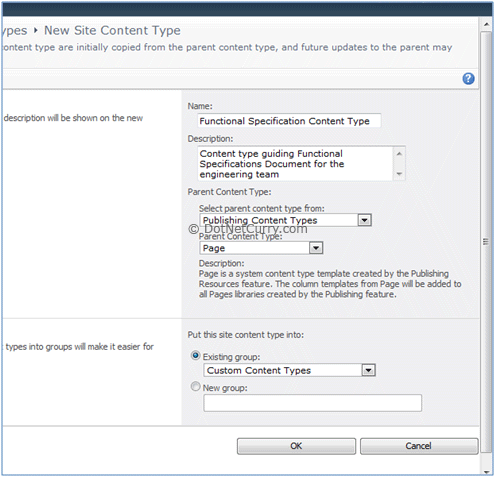
Click OK and add the required columns to the content type as defined in Step 6 in my
previous article.
You will notice a few
extra columns in the default content type this time, because our
content
type is inheriting from “Page” Content Type. You can keep them because
they are optional.
Best part about the custom page layout is you can
choose to show/hide the fields you want
for the document.
Once we are done adding
columns for our ‘Functional Specification’ the list of columns
should
look something like the list below.
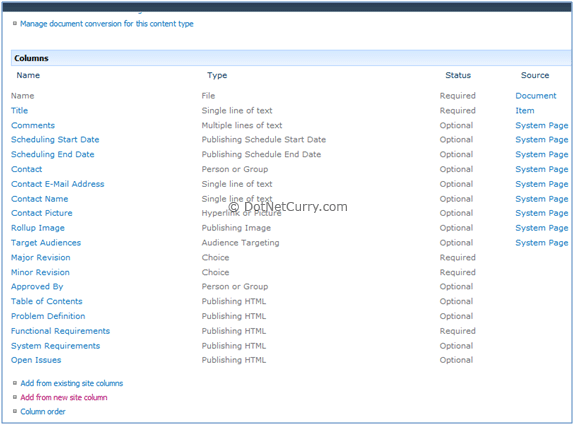
Note: It’s important
for the parent site to use a Publishing Site template. Else
custom page
layouts cannot be created through designer.
Creating Custom Page Layout
To create a custom page
layout we’ll use SharePoint Designer. It’s a freely
Step 1: Start SharePoint Designer.
Step 2: Select ‘Sites’ and click on ‘Open Site’.
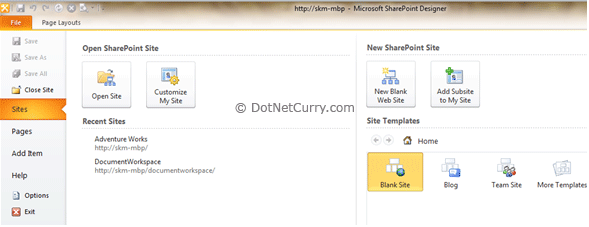
Step 3: Give the site name and click Open. You’ll be prompted for credentials. Provide
credentials of a site collection admin user.
Step 4: Under ‘Site Objects’ in the left navigation pane, select ‘Page Layouts’
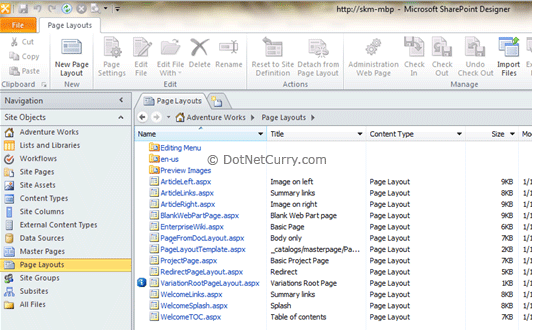
Step 5:
Click on ‘New Page Layout’ button in the ‘Page Layouts’ ribbon. You will
get a dialog asking you to select the content type. Here we will select
the custom
content type we created. Provide a filename in the URL Name
field and a page title
in the Title field. Click OK to continue.
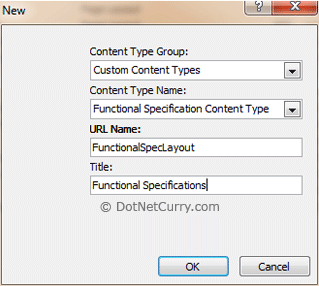
Step 6: In
a few seconds, the skeleton layout page (aspx) will be created and
opened in SPD. It’s a standard ASPX page. If you are not too much into
web
development, just
consider it as a well formed xml. All you care
about is putting your content in
<asp:Content
…>
</asp:Content> tags.
The thing of most
interest for us is the Toolbox on the right. Expand the SharePoint
Controls pane and you’ll see ‘Page Fields’ and ‘Content Fields’ section.
Here
you’ll see the Content Type columns we had defined have been all
pulled in.
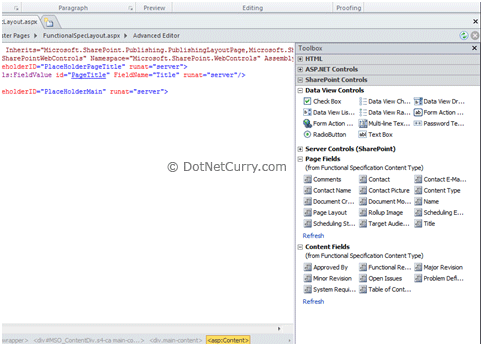
Step 7:
Drag and Drop all the fields you need on the ASPX page inside the
<asp:Content></asp:Content> tags. Unlike me if you are an
HTML/CSS guru,
here is where you get
creative. In the end, the page
should have all the content type fields you need and at a very
minimum
it will be good to include all the mandatory ones. My best effort looks
as follows:
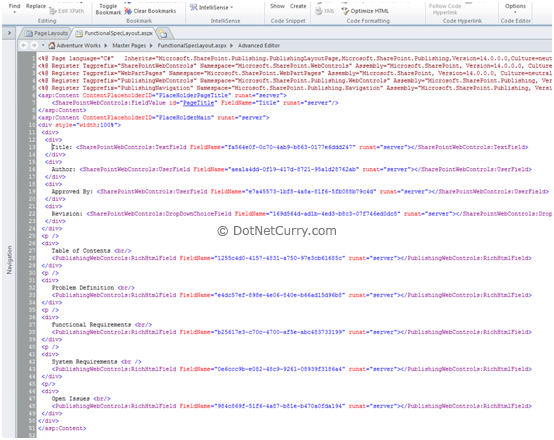
Note: Observe when you
drop the fields you have GUID only for the FieldName,
so you better
label them either before or immediately after you’ve dropped the field,
else you’ll
forget which field you dropped.
Step 8:
Save the page (trusty old Ctrl+S) and switch to the ‘Page Layouts’ tab.
Here you’ll see the ‘FunctionalSpectLayout.aspx’ has a checkmark against
its name.
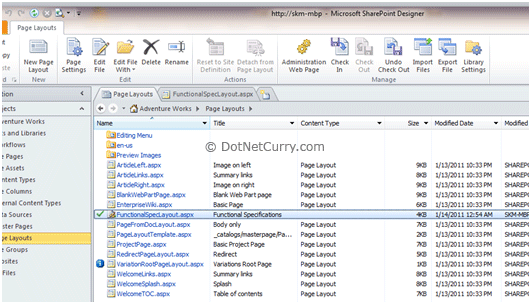
Step 9: Right click on ‘FunctionalSpecLayout.aspx’ and select ‘Check In’. You will
be prompted with a dialog as follows:
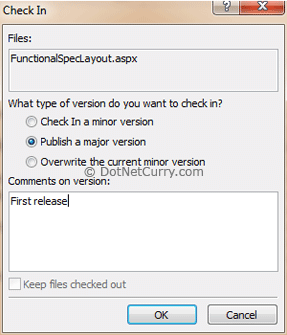
Make sure you select ‘Publish a major version’ because this is our first publish. Click OK.
Step 10: Clicking on OK will give you the following prompt

Click on ‘Yes’ and wait
for SPD to start your default browser. If asked for
credentials provide
credentials for a Site Collection Admin. A page similar to the
following will open up.
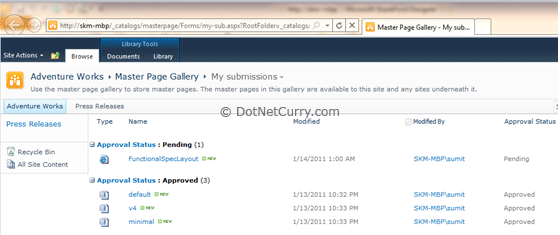
Step 10: Pull down the menu for the ‘FunctionalSpecLayout.aspx’ by click on the
down arrow. Select ‘Approve/Reject’ from the menu.
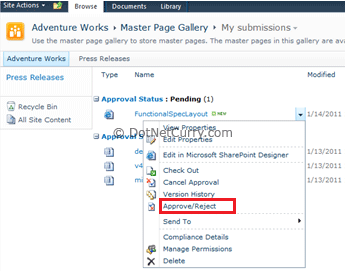
Step 11: It will pop-up a window with the following options. Select Approved,
provide comments and hit OK.
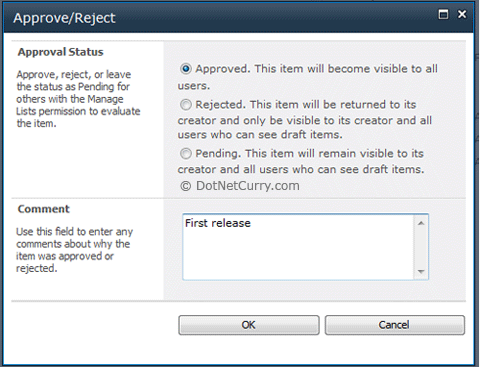
Our Custom layout is all but done. Now, let us test it out.
Step 12:
Select ‘Site Actions’ > ’Site Settings’. Under ‘Site Administration’
select ‘Site Libraries and Lists’. Click on ‘Customize “Pages”’ link. It
will take
us to the Page Library settings (shown below) where we’ll add
our content
type as one of the supported content types.
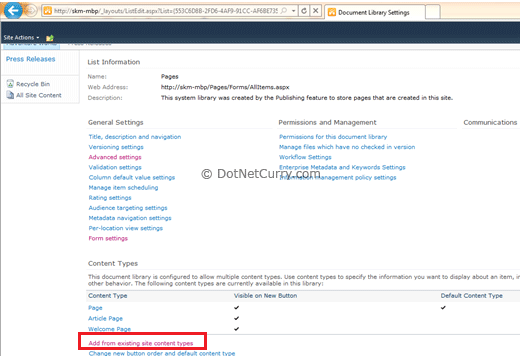
Step 13: Click on ‘Add from existing site content types’ to add our custom content type.
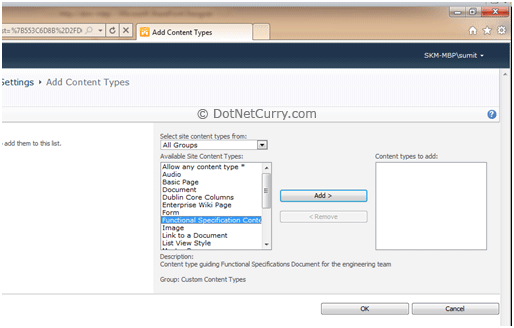
Step 14:
In the Above screen select our custom content type ‘Functional
Specifications Content Type’ and ‘Add’ it to the ‘Content Types to add’
list.
Click OK.
Step 15: Click on ‘Change new button order and default content type’ to
disable rest of the templates.
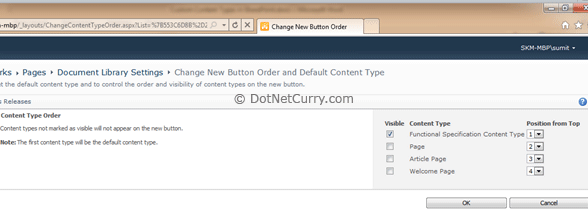
Click on the ‘Title, description and navigation’ select ‘Yes’ for visibility in quick launch.
That’s about it. We are all set to test our custom page layout for our very
own content type.
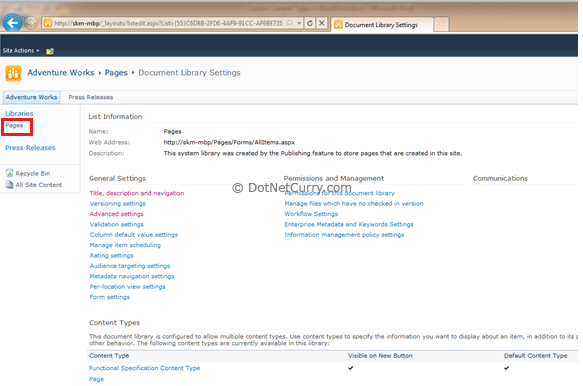
Step 16: In the quick launch bar on the left, click on Pages to go the page library.
You’ll see a page called default. Ignore this.
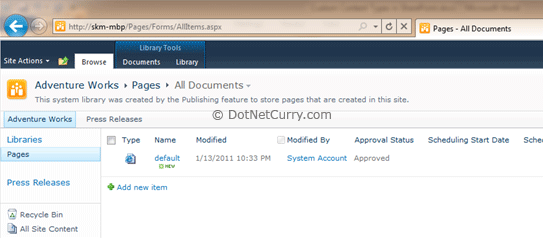
Click on Documents ribbon and Select ‘New Document’.
Step 17: You’ll be presented with Create new page screen. Fill in the ‘Title’ and
‘Description’. Change ‘URL Name’ if required.
Keep the Page Layout as functional specifications…
Click Create.
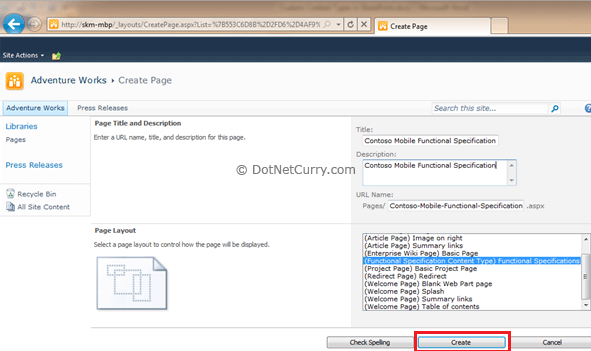
Step 19: You will navigate back to the Page library and our first functional spec will be
ready for editing
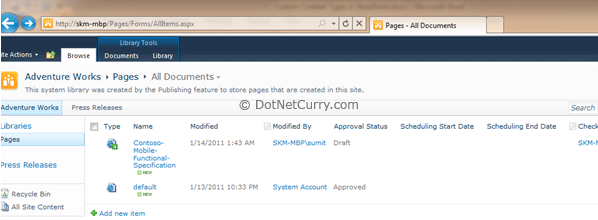
Step 20: Click on the Name to see the custom page layout.
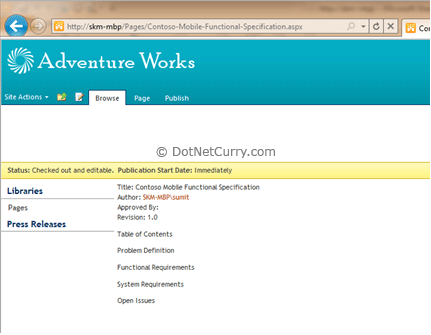
Ooohh so pretty!!!! (mimicking my 4 year old)
Now as you see
SharePoint is saying the page is checked out and editable. Then
why are
all the controls read-only? One last step to go.
Step 21: Select the Page ribbon and click on Edit button.
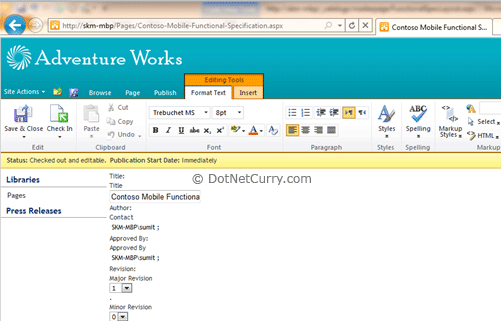
OMG where did my pretty
page go! Well, we forgot to tell SharePoint not to display labels
for
the fields in our page layout. But we will ignore that for a moment and
wonder
at SharePoint’s versatility.
See how the Contacts
have picker controls; Dropdowns come in for Choice and Rich text
editors
(that can pretty much do all the formatting you can do in Word) for
Rich HTML fields. All this and “look mama no code”!
Disabling Content Type Field Labels in Edit Mode
We saw in Step 21 above
how in Edit mode our custom page had duplicate labels.
One provided by
us in the layout page and another that corresponded to the Field
Name of
the Content Type. Ideally we would want complete control on our layout
so we would like to hide the Column Name that comes automatically. To do
this
we go back to SharePoint designer and do the following steps.
Step 1: Select FunctionalSpecLayout.aspx from the Page Layouts folder and click
on Edit. Say ‘Yes’ for all popups.
Step 2: For each field that we dropped add an attribute DisableInputFieldLabel with
value ‘true’.

Step 3: Once all fields have been updated with the new attribute, Save the file.
Step 4: Click on ‘Page Layouts’ in the left pane. On the right pane,
select ‘FunctionalSpecLayout.aspx’.
Step 5: In check-in confirmation dialog, check it in as a minor version.
Step 6: Navigate back to the Page library and edit the page. Confirm that the
duplicate labels are now gone.
Conclusion
In this article we saw
how a publishing site can be used to create custom content
type and then
define a custom page layout for the content type. So far we’ve
not
written a single line of code for all this work.
Next step in our
learning process is to use the SharePoint workflow to take our
document
through an approval process. Even more interesting is development
of a
SharePoint feature that will convert this editable page into a
non-editable
document of record.


No comments:
Post a Comment